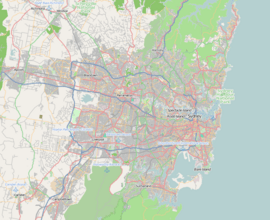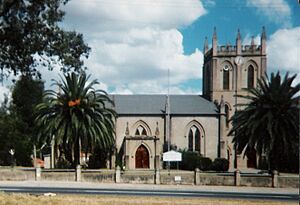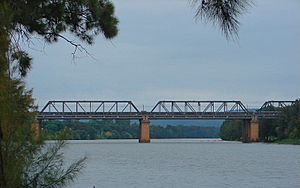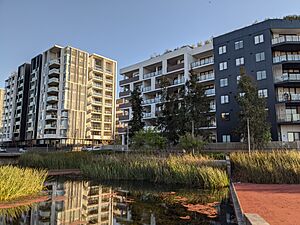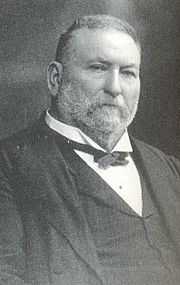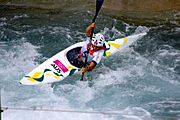Penrith, New South Wales facts for kids
Quick facts for kids PenrithSydney, New South Wales |
|||||||||||||||
|---|---|---|---|---|---|---|---|---|---|---|---|---|---|---|---|
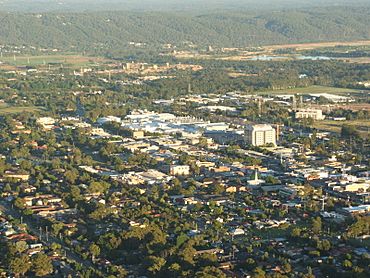
Penrith's central business district and commercial area
|
|||||||||||||||
| Established | 1815 | ||||||||||||||
| Postcode(s) | 2750 | ||||||||||||||
| Elevation | 32 m (105 ft) | ||||||||||||||
| Area | 12.33 km2 (4.8 sq mi) | ||||||||||||||
| Location |
|
||||||||||||||
| LGA(s) | City of Penrith | ||||||||||||||
| State electorate(s) | Penrith | ||||||||||||||
| Federal Division(s) | Lindsay | ||||||||||||||
|
|||||||||||||||
Penrith is a city in New South Wales, Australia. It is part of Greater Western Sydney. Penrith is about 55 kilometres (31 miles) west of the Sydney central business district. It sits on the banks of the Nepean River, at the edge of the Cumberland Plain. The city is about 32 metres (105 feet) above sea level.
Penrith is an important centre for local government. It is one of only four cities in the Greater Sydney area.
Contents
- Penrith's Past: A Journey Through Time
- Shopping and Business in Penrith
- Getting Around Penrith: Transport Links
- Learning in Penrith: Schools and Universities
- Fun Places and Landmarks in Penrith
- Penrith's Culture: Arts and Sports
- Penrith's Location and Weather
- Who Lives in Penrith? Demographics
- Famous People From Penrith
- Penrith's Sister Cities
- See also
Penrith's Past: A Journey Through Time
First People: The Mulgoa Tribe
Before Europeans arrived, the Penrith area was home to the Mulgoa tribe. They were part of the Darug people. They lived in simple huts called gunyahs. They hunted animals like kangaroos and fished in the Nepean River. They also gathered local fruits and vegetables. The Mulgoa people had a complex system of laws based on their Dreamtime beliefs. Sadly, many Mulgoa people died from smallpox soon after the First Fleet arrived in 1788. Early British explorers described them as friendly.
European Discoveries and Early Settlement
European history in Penrith began on June 26, 1789. An exploring group led by Captain Watkin Tench discovered the wide Nepean River. This was the first time Europeans saw the land where Penrith now stands. Captain Tench wrote that the river was "nearly as broad as the Thames". Governor Arthur Phillip later named the river after Evan Nepean.
Settlement by Europeans began in the early 1800s. Governor Phillip Gidley King started giving land to settlers in 1804. The first government building was a military depot. It was built in 1815 by William Cox. This building helped bring law and order to the area.
The name Penrith is a bit of a mystery. It might have been named after Penrith in England. This was possibly done by someone who saw similarities in the landscape. By 1819, the name Penrith was commonly used.
In 1814, William Cox built a road across the Blue Mountains. This road passed through Penrith. The area grew enough for a courthouse to be built in 1817. A post office opened in 1828. Churches were also built, like St Stephen's Anglican Church in 1839.
Important early settlers included Thomas Jamison and his son, Sir John Jamison. Sir John built a grand house called Regentville House in 1824. It was a large farm overlooking the Nepean River. The house burned down in 1868.
The first bridge over the Nepean River opened in 1856. However, a flood washed it away the next year. The railway line reached Penrith in 1863. Penrith became a municipality in 1871 and officially a city in 1959.
Shopping and Business in Penrith
Penrith is a major shopping and business hub in Greater Western Sydney. The city has two main shopping centres:
- Westfield Penrith: This is the biggest shopping centre in Penrith. It opened in 1971 and was bought by Westfield in 2005.
- Nepean Village: This is a single-level shopping centre. It has popular stores like Kmart and Coles.
Getting Around Penrith: Transport Links
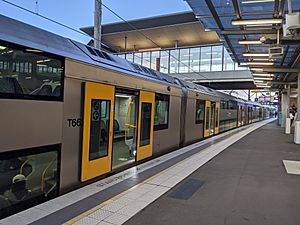
Penrith railway station is a very busy train station. It is on the Main Western railway line. Trains run often to and from Sydney. It is also a stop for intercity trains on the Blue Mountains Line.
Buses also connect at the Penrith railway station.
You can reach Penrith by car using the Great Western Highway. If you are coming from further east, the M4 Western Motorway is the best way. From the Blue Mountains, you can use the Great Western Highway. Other roads like The Northern Road and Mulgoa Road also lead to Penrith.
Learning in Penrith: Schools and Universities
Penrith has several schools:
- Penrith Public School
- Penrith High School
- Jamison High School (in South Penrith)
- St Nicholas of Myra (a Catholic primary school)
For older students, there is the Penrith campus of Nepean College of TAFE. The University of Western Sydney also has a campus nearby in Werrington. The University of Sydney has a campus near Nepean Hospital for medical research and teaching.
Fun Places and Landmarks in Penrith
Penrith has many interesting places, some with a lot of history:
- Craithes House
- Torin Building
- Penrith railway station, Sydney
- Victoria Bridge (Penrith) over the Nepean River
- Emu Plains Underbridge
- Penrith Museum of Fire: This museum has a collection of old fire engines and equipment.
- Nepean Belle: An old-style paddlewheeler boat on the Nepean River.
- St Stephen's Church (built in 1839) and its old graveyard.
- Sydney International Regatta Centre: This is where the rowing events for the 2000 Olympic Games were held.
- Panthers World of Entertainment
- Nepean River
- Red Cow Hotel: Penrith's oldest hotel still standing.
- Thornton Hall
- Nepean Park
Penrith's Culture: Arts and Sports
Arts and Performance
The Joan Sutherland Performing Arts Complex is a major arts venue. It is named after the famous opera singer Joan Sutherland. The building opened in 1990. It includes the Penrith Conservatorium of Music and the Q Theatre (Penrith).
Sports and Recreation
Penrith Stadium is the home ground for the Penrith Panthers NRL (rugby league) team. Penrith has the largest Junior Rugby League competition in the world. It includes teams from nearby areas too.
Many other sports are popular in Penrith. These include cricket, AFL, triathlon, Penrith Emus Rugby, swimming, and soccer.
Just west of Cranebrook are Penrith Lakes. These are old quarries that are now lakes for recreation. One of these lakes hosted the rowing events for the Sydney 2000 Olympics. It is a top-level course for international events.
North of the rowing lake is the Penrith Whitewater Stadium. This is the only pump-powered artificial whitewater course in the Southern Hemisphere. It was also built for the Sydney 2000 Olympics. It still hosts international competitions.
Penrith is also home to the first Flip Out trampoline arena. It opened in 2012 and has grown into a big franchise. The Penrith Softball Club, founded in 1975, is also very active.
Media
Penrith has local newspapers like The Western Weekender and Nepean News. The Western Weekender is published weekly and has online news. In 2001, the Penrith Museum of Printing opened. It shows the history of printing in Australia.
Penrith's Location and Weather
Geography of Penrith
Penrith is on the western edge of the Cumberland Plain. This is a mostly flat area in Western Sydney. The Nepean River forms the western border of the suburb. Beyond the river, you can see the Blue Mountains in the distance.
Penrith's Climate
Penrith has a humid subtropical climate. This means it has long, hot summers and mild, short winters. Spring and autumn are pleasant. Daytime temperatures in Penrith are usually warmer than in central Sydney. This is especially true in summer. Night-time temperatures are often cooler.
Sometimes, frost can happen on winter mornings. This is because of cool air coming from the mountains. The average summer temperature is between 17.9 °C (64.2 °F) and 29.8 °C (85.6 °F). In winter, it ranges from 6.2 °C (43.2 °F) to 18.6 °C (65.5 °F).
Penrith gets less rain than areas closer to the coast. The highest temperature ever recorded was 48.9 °C (120.0 °F) on January 4, 2020. The lowest was -1.8 °C (28.7 °F) on July 16, 2018. Penrith's hot temperatures are due to its inland location and the way the Blue Mountains can trap hot air.
| Climate data for Penrith Lakes AWS (1995−) | |||||||||||||
|---|---|---|---|---|---|---|---|---|---|---|---|---|---|
| Month | Jan | Feb | Mar | Apr | May | Jun | Jul | Aug | Sep | Oct | Nov | Dec | Year |
| Record high °C (°F) | 48.9 (120.0) |
46.9 (116.4) |
40.6 (105.1) |
36.6 (97.9) |
29.4 (84.9) |
26.0 (78.8) |
28.2 (82.8) |
29.7 (85.5) |
37.3 (99.1) |
38.9 (102.0) |
44.9 (112.8) |
46.3 (115.3) |
48.9 (120.0) |
| Mean daily maximum °C (°F) | 30.8 (87.4) |
29.6 (85.3) |
27.6 (81.7) |
24.7 (76.5) |
21.2 (70.2) |
18.2 (64.8) |
18.1 (64.6) |
20.0 (68.0) |
23.4 (74.1) |
25.9 (78.6) |
27.5 (81.5) |
29.7 (85.5) |
24.7 (76.5) |
| Mean daily minimum °C (°F) | 18.6 (65.5) |
18.5 (65.3) |
16.8 (62.2) |
13.1 (55.6) |
9.2 (48.6) |
6.8 (44.2) |
5.4 (41.7) |
6.2 (43.2) |
9.3 (48.7) |
12.3 (54.1) |
15.0 (59.0) |
17.0 (62.6) |
12.4 (54.2) |
| Record low °C (°F) | 10.6 (51.1) |
11.6 (52.9) |
8.3 (46.9) |
3.6 (38.5) |
1.3 (34.3) |
−1.1 (30.0) |
−1.8 (28.8) |
−0.5 (31.1) |
2.2 (36.0) |
5.0 (41.0) |
7.8 (46.0) |
9.8 (49.6) |
−1.8 (28.8) |
| Average precipitation mm (inches) | 95.1 (3.74) |
118.8 (4.68) |
104.7 (4.12) |
50.2 (1.98) |
35.2 (1.39) |
45.2 (1.78) |
37.2 (1.46) |
30.8 (1.21) |
31.7 (1.25) |
54.9 (2.16) |
83.5 (3.29) |
65.0 (2.56) |
752.3 (29.62) |
| Average precipitation days (≥ 1.0 mm) | 7.8 | 8.4 | 8.6 | 5.9 | 4.2 | 5.5 | 4.3 | 3.4 | 4.8 | 5.4 | 7.7 | 7.3 | 73.3 |
| Average afternoon relative humidity (%) | 47 | 53 | 52 | 49 | 52 | 55 | 50 | 41 | 40 | 41 | 46 | 45 | 48 |
| Average dew point °C (°F) | 14.7 (58.5) |
16.2 (61.2) |
14.4 (57.9) |
10.8 (51.4) |
8.9 (48.0) |
7.2 (45.0) |
5.2 (41.4) |
3.9 (39.0) |
6.2 (43.2) |
7.5 (45.5) |
10.8 (51.4) |
12.6 (54.7) |
9.9 (49.8) |
| Source: Bureau of Meteorology (temperatures, humidity and rainfall) | |||||||||||||
Who Lives in Penrith? Demographics
| Historical population | ||
|---|---|---|
| Year | Pop. | ±% |
| 2001 | 11,563 | — |
| 2006 | 11,396 | −1.4% |
| 2011 | 11,813 | +3.7% |
| 2016 | 13,295 | +12.5% |
| 2021 | 17,966 | +35.1% |
In 2021, Penrith had a population of 17,966 people.
- Age: The average age was 36 years old. About 15% of the population were under 15.
- First Nations People: Aboriginal and Torres Strait Islander people made up 6.2% of the population.
- Backgrounds: Most people (65.8%) were born in Australia. Other common birthplaces included England, India, the Philippines, New Zealand, and China.
- Languages: 71.9% of people spoke only English at home. Other languages included Mandarin, Tagalog, Hindi, Korean, and Arabic.
- Religion: The most common responses for religion were No Religion (35.1%), Catholic (20.7%), and Anglican (12.3%).
- Homes: About 36% of homes were separate houses. About 43% were flats, units, or apartments.
Famous People From Penrith
Many notable people have connections to Penrith, including:
- Richie Benaud (1930−2015), a famous cricketer and commentator.
- Thomas Bent (1838−1909), who was the Premier of Victoria.
- Nathan Bracken (b. 1977), an Australian cricketer.
- Jason Dundas (b. 1981), a television presenter.
- Mick Fanning (b. 1981), a surfing world champion.
- Jessica Fox (b. 1994), an Olympic gold medalist in canoeing.
- Mark Geyer (b. 1967), a former rugby league player.
- John Hastings (b. 1985), a former Australian cricketer.
- Dominic Purcell (b. 1970), an actor known for Prison Break.
- Many rugby league players, including Nathan Cleary, Craig Gower, and Luke Lewis.
Penrith's Sister Cities
Penrith has special connections with cities around the world. These are called "sister cities" or "friendship cities":
 Fujieda, Shizuoka, Japan (since 1984)
Fujieda, Shizuoka, Japan (since 1984) Penrith, Cumbria, United Kingdom (since 1989)
Penrith, Cumbria, United Kingdom (since 1989) Gangseo District, Seoul, Republic of Korea (since 1994)
Gangseo District, Seoul, Republic of Korea (since 1994) Xicheng District, Beijing, China (since 1998)
Xicheng District, Beijing, China (since 1998) Kunshan, China (since 2003)
Kunshan, China (since 2003) Hakusan, Ishikawa, Japan (since 2005)
Hakusan, Ishikawa, Japan (since 2005)
See also
 In Spanish: Penrith (Nueva Gales del Sur) para niños
In Spanish: Penrith (Nueva Gales del Sur) para niños


